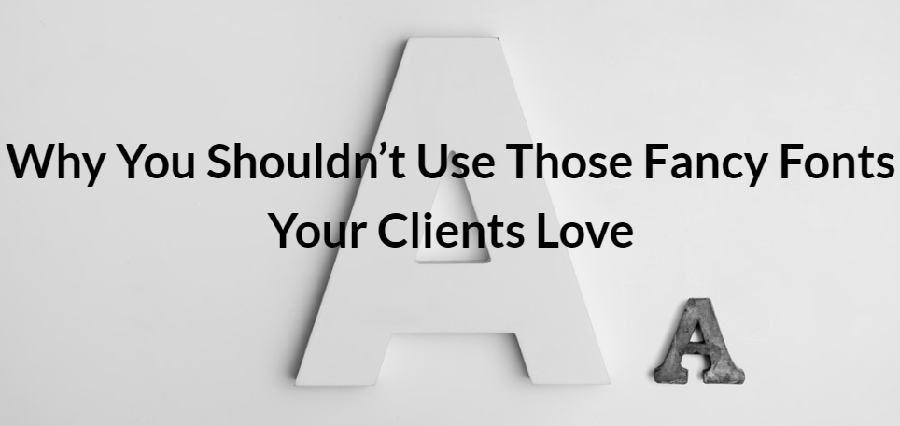Why You Shouldn’t Use Those Fancy Fonts Your Clients Love
When you tell most clients you’re going to work on the “typography” for their website, they tend to think you’re going to find a unique, memorable font face that will accurately portray their company’s brand image. When you publish their content in Helvetica or Arial, they’re disappointed and might ask you to do something else to make their website “pop.”

As a developer, it’s your duty to maintain the integrity of the website you’re being paid to create. It’s worth explaining, in detail, to your clients when their font preferences aren’t going to support their goals.
While typography is the visual component of the written word, it’s not just about finding a good-looking font. Sometimes fancy fonts are appropriate, but sometimes the most beautiful fonts do more harm than good.
Typography functions mainly as a utility
Typography, while visual, serves a functional purpose within the design of a website. Great typography is designed for the reader, not for the business. Typography has a reputation for being an opportunity for creative expression, but its main function is to capture and maintain reader attention.
PracticalTypography.com explains, “Is typography an art? That’s like asking if photography is an art. Certainly there are photographers and typographers whose ideas and techniques raise their work to the level of art. But at their core, both photography and typography perform a utilitarian function. The aesthetic component is separate. Being an effective typographer is more about good skills than good taste.”
Typography skills need to be developed
Having good typography skills is essential to building a successful website for your clients. No matter how amazing their product is, the typography will determine how much attention is given to the content. You could have sales copy written by Dan Kennedy – the highest paid copywriter in the world – and if the typography is poor, the website won’t do well.
Good typography is characterized by the following elements:
- A thorough understanding of what the text is supposed to do. Personal preference has no place in the creation of good typography. The visual presentation of the text should support and reinforce the message.
- Visual elements that don’t undermine the text. As a designer, you love to get creative, but when your message needs to be read quickly and thoroughly, you’ll leave out elements that undermine the readability of the text. US road signs, like speed limit signs, are the perfect example of no-frills text that can be read quickly. Drivers depend on the fast readability of road signs.
- Elements that promote legibility. Line spacing, letter spacing, line height, margins, and padding between headings and paragraphs matter. Small changes in these elements can increase or decrease the legibility of text. For instance, Green Residential’s typography is completely legible with a sans serif font, gentle colors that don’t distract, and line spacing that’s slightly larger than normal.
Typography can make or break a website
When a client hires you to design a website for them, you’re responsible for implementing best practices that will support them in achieving their goals. It might be easier to go with the client’s suggestions for typographical style, but it’s almost never in their best interest.
Typography determines the first impression people have when they land on a webpage. The more organized and readable the text is, the more likely that they’ll stick around. If you’re wondering how you can improve a client’s bounce rate, you may want to start with typography before you change button colors and rearrange elements on the page.
Test your own typographical preferences, as a reader, with this simple exercise comparing two resumes, and you’ll understand how great typography can make or break a website in mere seconds.
Don’t get too fancy with logos
The marketing world is filled with beautiful examples of creative fonts used well in logos. These examples can be seen in the logos of big brands like Pepsi, Coca-Cola, Subway, 7-Eleven, and AMC Theatres. All of these logos are crafted from a unique, creative font shaped into the design of the logo itself. The typography of these logos can be considered art, however, when smaller businesses attempt to do the same, the logos end up busy and disjointed.
Big brands spend big money to have their logos developed by marketing professionals with a background in psychology. There’s a difference between being a creative designer and a marketing professional. If your clients want you to develop a fancy logo for them, make sure your design stays aligned with the client’s goals.
Although nobody wants to pass up money, don’t hesitate to pass the project on to another designer if your client wants to use typographical elements that don’t serve their business.
